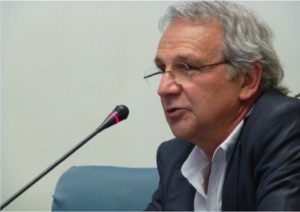The occupied Palestine may be viewed as the intersection of public health, human rights and international humanitarian law. She is therefore well suited to illustrate the new concept of Global Health intended as a "reflecting critical space" which recognises transnational health and disease processes as "strongly socially oriented and characterized by the paradigm of complexity (and therefore necessarily interdisciplinary)". A global model of socio-political determination of health, the occupied Palestine serves as a lens through which to verify the seriousness of our commitment to the norms and principles that seventy years ago the whole humanity, as United Nations (UN), has consensually founded to protect her survival

By Angelo Stefanini
Centre for International Health, University of Bologna (Italy)
Global Health and Occupied Palestine
“The metaphor for Palestine is stronger than the Palestine of reality.”
Mahmoud Darwish, Palestinian poet, 1941-2008
Discussing Global Health in the occupied Palestine[1] entails exploring crucial issues of great importance for a region that for over fifty years has being militarily occupied, progressively colonized and violated in its fundamental rights[2].
Global Health can be defined as a “reflecting critical space” which recognises transnational health and disease processes as “strongly socially oriented and characterized by the paradigm of complexity (and therefore necessarily interdisciplinary)”[3]. It is thus not surprising that the current, pervasive bio-medical culture, which claims to be a-political, finds considerable difficulty in conceptualizing this vision of social and political determination of health.
To understand why what happens in the occupied Palestine and to the health of Palestinians does matter to the health of the entire world, it is necessary to situate the local liberation struggle in relation to a number of global processes that, directly or indirectly, affect the daily life of all of us.
Neo-liberalism as National Liberation (or “Free Market in an Occupied Country”)
A global process differently perceived by a large part of the world population and with a profound relevance to the Palestinian case is the widespread, increasing loss of fundamental human rights (such as health, education, work, etc.) which neo-liberal globalization has being brought about over the last decades.
Despite being born as an integral part of a broader political project of anti-colonial struggle and creation of a just world order, the Palestinian national liberation movement, once in power as Palestinian National Authority (PNA), did not keep its promises and ended up protecting the privileges of the national bourgeoisie and of international investors[4].
As happened to the African National Congress (ANC) in South Africa and to the countries of the former Soviet bloc, PNA has been the victim of the neoliberal globalization’s irresistible “logic” that has seen it suddenly becoming, through a boldly crafted shock therapy[5], an emblematic case of authoritarian neoliberalism.
The 2009 programme document for the creation of the Palestinian state, unsurprisingly highly commended by the World Bank and the International Monetary Fund (IMF), asserts “The economic system in Palestine shall be based on the principles of a free market economy”[6]. In the context of a historic crisis of legitimacy of the Palestinian national movement, torn apart by unprecedented internal political divisions, the programme, drafted by an unelected government and headed by a prime minister, Salam Fayad, direct expression of the IMF, outlines an apparently autonomous strategy to achieve the form of a state based on neoliberal orthodoxy, where cuts in public expenditures, trade liberalization and privatization of state enterprises are top of the agenda. Warmly received by a predictably favourable international recognition, this national emancipation through neoliberalism actually redefines a type of Palestinian liberation struggle so far unknown: “Neo-liberalism as national liberation”[7].
In reality, the occupied Palestine ironically illustrates how a neoliberal economic regime under colonial yoke may turn out as a case of captive economy[8]. In fact, in the West Bank and Gaza Strip a complex system of military and civil laws and regulations dictated by the occupying power ensures that a “free” market, where the Palestinian pharmaceutical industry might indeed have a significant role to play, is instead “prisoner”, dominated by Israeli and international competition with detrimental effects on the price of drugs and consequent restricted access to health care for the Palestinian population.
A model of a “state of exception”
A second global process with both direct and indirect effects on global health is the relentless weakening of the international legal framework established at the end of the Second World War, i.e. the international humanitarian and human rights law with the United Nations (UN) as its guarantor. This disastrous trend goes along with the international community’s acquiescent acknowledgment of being in a constant “state of exception”[9], characterized by the legal suspension of the rule of law and consequent enactment of liberticidal laws as an ordinary condition for waging the “war on terrorism”. In such a context the construction of walls, real and symbolic, emerges as the coherent answer to the unstoppable migratory phenomenon and to the flight of desperate masses from violent conflicts, natural disasters and despair.
If this is the condition that now seems to be looming over the Western world in the near future, the same has been for years the daily life of occupied Palestine. The wall that Israel has built, not just to lock the Palestinians in their own land but as a new border that transfers vast areas of that region to the Israeli side, embodies the violent and overpowering nature of those everywhere building barriers with the false pretext of security. Every year a Special Rapporteur, an independent expert appointed by the United Nations Human Rights Council, reports on the situation of human rights in the Palestinian territories occupied since 1967. His/her findings, describing in detail the violations of Palestinian human rights carried out by the state of Israel, are publicly available[10]. Dozens of resolutions and UN requests to end Israel’s prolonged occupation and allow the Palestinian people to exercise its right to self-determination have been falling unheard.
The failure of the international community to respond to this arbitrary behaviour has produced a culture of impunity that allows Israel to feel entitled to any wrongdoing. At the peak of the recent so-called “stabbing intifada”, only brave journalists like the Israeli Amira Hass[11] dare to ask whether the army world leader in self-defence techniques has no choice but to execute in cold blood young assailants holding bare knives. Israeli “exceptionalism” has not only become normal, indeed is providing a precedent that other countries do not hesitate to follow in their own “war on terrorism”.
Similarly, the same oppressor, the Israeli settler who is illegally[12] grabbing Palestinian land in the West Bank and East Jerusalem, is shamelessly making a surreal inversion of the principle of human rights and of the categories of victimhood, guilt and abuse. This has given rise to the human right of settlers to expropriate indigenous populations, the human right to war legalized with drones, the human right to targeted killings and summary executions[13].
Global War Lab
The occupied Palestine illustrates the disturbing example of how Western powers understand “global war”. It is a subliminal surveillance war that the Israeli anthropologist Jeff Halper defines “securocratic war”, disguised as a “war on terrorism”, which fuels fear among the population, thus justifying the militarization of everyday life and of the whole society. What is needed to conduct this war is not only sophisticated conventional weapons; new military equipment, hi-tech surveillance systems, crowd control and biometric data collection are the novel tools of the trade[14].
This system of repression and control has been, and continues to be designed and tested in Israel and in the occupied territories over decades of “counter-insurgency” against the Palestinian population. In fact, the occupied Palestine represents the human laboratory in which Israel has been able to develop the skills and the technologies to promote herself to the outside world as “securityland”.
According to Jeff Halper, the importance of this mode of control lies in the fact that it responds to the ever more pressing preoccupation of global capitalism to maintain a favourable social order against the intolerable situations that it has created, such as increasing inequalities, civil wars and forced migration of hopeless populations.
From the “Israelification” of the US police to the “Palestinization” of the African-American uprising in Ferguson, Iraq and the refugee problem in the Middle East, the global ramifications of the Palestinian case are numerous.[15] [16]
The occupied Palestine as a global laboratory of the advancing hegemony of the state of security is also functional to the normalization and institutionalization of the so-called “chronic emergencies”, an oxymoron that is now part of the humanitarian language. Accepting this condition of chronicity as inevitable and necessary, in fact, is tantamount to legitimize a nation-state which on the altar of “security” has founded its existence, which may justify everything, even the unjustifiable, as a “right of self-defence” and on this right it builds its own case for impunity.
As stated by the Israeli historian Avi Shlaim in the wake of the Israeli attack on Gaza in 2009: “The unreported goal [of the war] is that the Palestinians of Gaza are seen by the world simply as a humanitarian problem thus deflating their struggle for the independence and for the birth of a state”.[17]
As long as a situation is defined as ‘emergency’, thus urging short-term interventions, the structural causes that are at the roots of the problem will inevitably remain in the background and distant in time.
The case of the occupied Palestine and of Gaza in particular as a humanitarian problem is evidently an expression of a global crisis of humanitarianism applicable to a number of other geo-political areas which for obvious, if unspeakable, interests the entire world prefers to see as “simple” humanitarian crises and where it is precisely these noble humanitarian efforts that prevent, perhaps unconsciously, a political solution.
Conclusion
The occupied Palestine portrays the image of a geo-political and symbolic space where global dynamics such as public health, human rights and international humanitarian law intersect. Far from being simply influenced by these processes, Palestine serves as a lens through which to verify the seriousness of our commitment to the norms and principles that the whole humanity has consensually founded to protect her survival. This was certainly what Nelson Mandela meant when he described Palestine as “the greatest moral question of our time”.
Note:
A slightly different Italian version of this post appeared on the blog saluteinternazionale.info at this link http://www.saluteinternazionale.info/2017/09/palestina-neo-liberismo-in-paese-occupato/
References
[1]These personal reflections are the result of the discussion that invigorated an otherwise perhaps boring training course (entitled “An Introduction to Global Health and Its Relevance to Palestine”) held from July 10 to 13, 2017 at the University of Birzeit (occupied West Bank). I thank the participants of the course for their unaware contribution to this paper.
[2] Israel: 50 Years of Occupation Abuses. Human Rights Watch, 04.06.2017. https://www.hrw.org/news/2017/06/04/israel-50-years-occupation-abuses Accessed on 02/03/2018.
[3] Stefanini A, Bodini C. (2016) Salute Globale: Uno Scenario Conflittuale, in (a cura di) A.A. Ferla, A. Stefanini, A. Martino, Salute Globale in una Prospettiva Comparata tra Brasile e Italia, Porto Alegre, Brasile/Bologna, Italia – Rede UNIDA/CSI-Unibo. Pp. 13-34.
[4] Khalidi R, Samour S. Neoliberalism as liberation: The statehood program and the remaking of the Palestinian national movement. Journal of Palestine Studies 2011; 40(2), 6-25.
[5] Klein N., The Shock Doctrine: The Rise of Disaster Capitalism. Penguin, 2007.
[6] Ending the Occupation, Establishing the State (Ramallah: Palestinian National Authority, 2009). P.7. https://unispal.un.org/pdfs/PA_EndingOccupation-Statehood.pdf Accessed on 02/03/2018.
[7] Khalidi R, Samour S. (2011) Op.cit.
[8] Captive Economy. The Pharmaceutical Industry and the Israeli Occupation. The Coalition of Women for Peace / Who Profits, March 2012. https://whoprofits.org/sites/default/files/captive_economy_0.pdf Accessed on 02/03/2018.
[9] Agamben G., Stato di eccezione. Torino: Bollati Boringhieri, 2003. English translation: Agamben G., State of exception, University of Chicago, 2005.
[10] Situation of human rights in the Palestinian territories occupied since 1967. https://documents-dds-ny.un.org/doc/UNDOC/GEN/N17/340/02/PDF/N1734002.pdf?OpenElement Accessed on 02/03/2018.
[11] Hass A., Israel’s Cloned Security Guards. Haaretz.com, 26.07.2017. https://www.haaretz.com/opinion/.premium-israel-s-cloned-security-guards-1.5434828 Accessed on 02/03/2018.
[12] Resolution 2334 (2016) Adopted by the Security Council at its 7853rd meeting. 23.12.2016 http://www.un.org/webcast/pdfs/SRES2334-2016.pdf Accessed on 02/03/2018.
[13] Perugini N. and Gordon N., The Human Right to Dominate, Oxford University Press, 2015.
[14] Halper J., War Against the People: Israel, the Palestinians and Global Pacification, Chicago University Press, 2014.
[15] Giraldi P., America’s Militarized Police – Made in Israel? The Unz Review, July 25, 2017. http://www.unz.com/pgiraldi/americas-militarized-police/ Accessed on 02/03/2018.
[16] Tamari S. and Thompson T., From Ferguson to Palestine, We See Us. Huffingtonpost.com, 10.16.2015. https://www.huffingtonpost.com/sandra-tamari/from-ferguson-to-palestine_b_8307832.html Accessed on 02/03/2018
[17] Feldman I. Gaza’s Humanitarianism Problem. Journal of Palestine Studies 2009; 38(3), 22-37.









